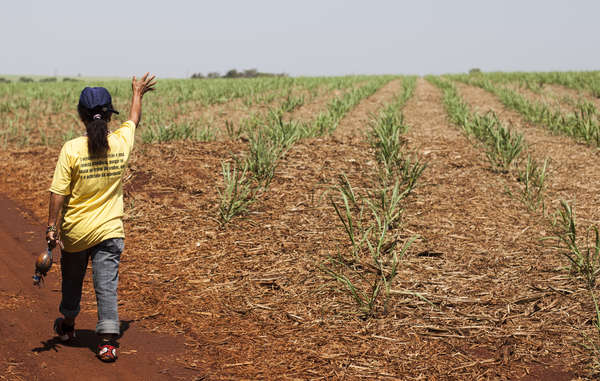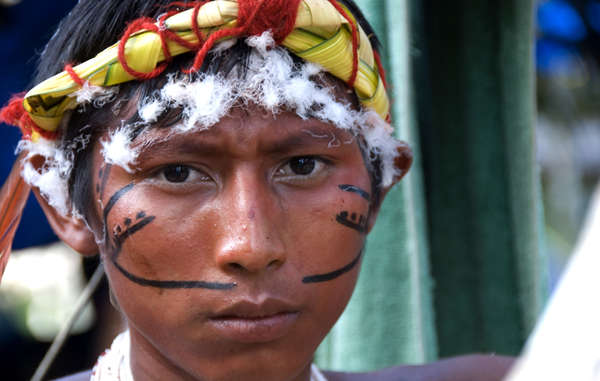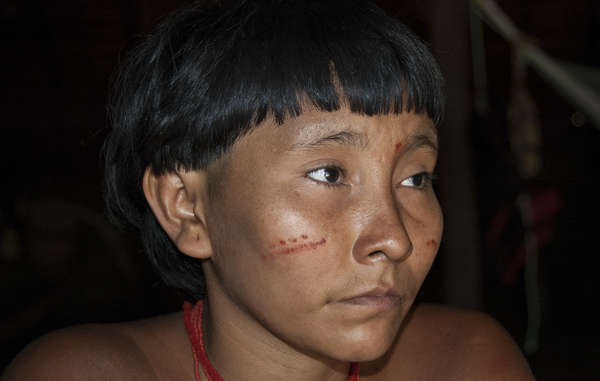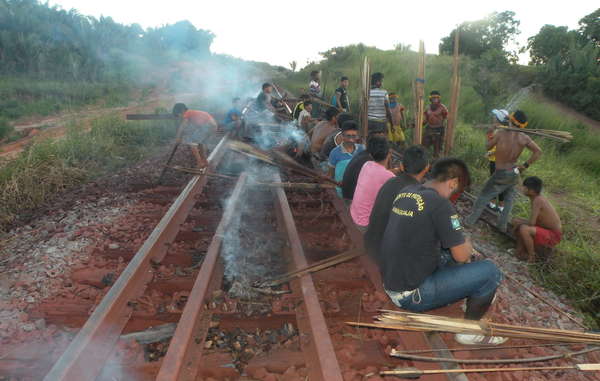
by Deep Green Resistance News Service | Jun 20, 2016 | Obstruction & Occupation
Featured image: The blockade. This is the first time the Awá have initiated a protest of this kind on their own. © Survival International
By Survival International
Members of Brazil’s Awá tribe have blockaded a railroad owned by Vale mining company in the eastern Amazon.
The company has moved to expand the railroad, but the Awá say the expansion will increase the number and size of trains which transport iron ore from the Carajás mine to the port of São Luis – and that this will make it harder for them to hunt for food.
Carajás is the world’s largest open pit iron ore mine. To transport the iron ore, trains that are over 3 kilometers in length regularly hurtle through close to Awá territory.
The tribe are calling for a meeting with the company and FUNAI, the Brazilian government’s indigenous affairs department, so that their wishes can be heard and their rights respected.
On Saturday a large group of Awá families occupied a section of the railroad which runs alongside their land.
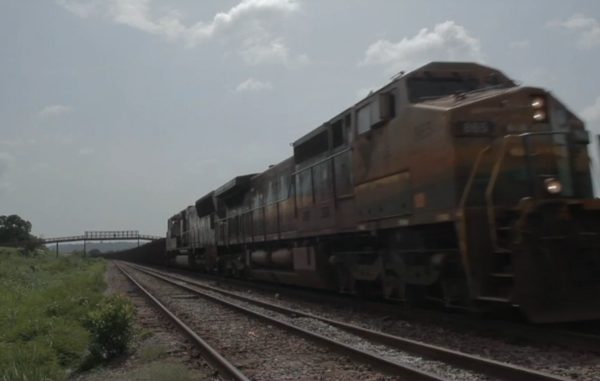
At over 300 carriages in length, the Carajás train is among the longest in the world, and seriously disrupts the animals the Awá depend on for food
© Screenshot
Following a meeting with Vale representatives yesterday, the Awá agreed to suspend the blockade on condition that the company upholds its agreement to mitigate the impacts on the Indians’ forest.
This is the first time that the Awá have blockaded the railroad on their own initiative and reflects their determination to hold Vale to account.
In April 2014 Survival’s international campaign succeeded in pushing the Brazilian government to evict illegal loggers and settlers who had destroyed over 30% of their central territory.
However, the Awá are still one of the most vulnerable peoples on the planet. Around 100 remain uncontacted and are very vulnerable to diseases brought in by outsiders, to which they have no resistance.
Last year fires, possibly started by loggers, ravaged one Awá territory, home to the largest group of uncontacted members of the tribe.
Act now to help the Awá
Your support is vital if the Awá are to survive. There are many ways you can help.
by Deep Green Resistance News Service | May 31, 2016 | Agriculture, Colonialism & Conquest
Featured image: Combine harvesters crop soybeans during a demonstration for the press, in Campo Novo do Parecis, Brazil, on March 27, 2012. By Phys.org.
By Manuela Picq / Intercontinental Cry
Soy has become quite fashionable as a “wonder food.” Praised for its nutritional values, soy has the highest protein content of any bean making it a favorite among vegans, animal defenders and even young hipsters who swear by their morning soy latte. For many, however, soy is an ethical and political choice. By switching to soy, we get to spare our bodies and the planet from the harmful effects of the meat and dairy industry, its extensive use of antibiotics and its heavy contribution to the ever-growing climate crisis.
The problem is, soy production is a veritable criminal enterprise. The impressive bean that so many of us love is grown by multinational corporations that poison soil and water with toxic agrochemicals. What’s more, the bean is a Monsanto genetically modified crop the full impacts of which are still unknown. Soy is also used extensively by livestock producers alongside genetically modified corn as a base for animal feed. On top of this toxic burden, the soy agribusiness industry expropriates Indigenous Peoples. Also it destroys forests. And, like the meat and dairy industry, it’s fueling the climate crisis.
Let’s take a closer look at these four interrelated reasons why we need to move away from soy, in its many forms.
1) THE EXPANSION OF SOY MONOCULTURE IS RESPONSIBLE FOR MASSIVE DEFORESTATION AND CLIMATE CHANGE
Growing soy requires vast extensions of land. In fact, it requires so much land that soy monoculture a leading factor in the destruction of the world’s biodiversity. Soy farms now cover more than one million square kilometers of the world – the total combined area of France, Germany, Belgium and the Netherlands. The soy agriculture industry is having an especially devastating impact in Amazonia but also in the Cerrado and the Chaco. Almost 4 million hectares of forests are destroyed every year, 2.6 million in Brazil alone, the world’s leading soy producer.
Compounding this rampant devastation, when forests are transformed into farmland, soil quality deteriorates, leading to increased pollution, increased flooding and increased sedimentation that can clog waterways. This can cause a significant decline in fish populations and other life. Agrochemical residues degrade soil even further, along with the local water table and natural processes such as pollination. Such loss of biodiversity is a key factor of climate change.
2) THE GLOBAL SOY INDUSTRY HAS INDIGENOUS BLOOD ON ITS HANDS
The expansion of soy is made possible through land grabbing and by provoking land conflicts. Indigenous Peoples are often the main victims of this expropriation and dispossession and are often forced into urban poverty as a result. Indigenous resistance, however, is brutally repressed.
In Brazil, the Kaiowá-Guarani peoples have denounced over three hundred assassinations. Indigenous peoples defending their land are being killed by private militias hired by large soy corporations like Raizen, Breyfuss, Bunge, Syngenta and the French-Swiss Louis Dreyfus Commodities. “The soy you consume is stained with Guarani Kaiowá blood,” said Valdelice Veron, the daughter of cacique killed by a soy producer in 2003.
One emblematic case was the brutal homicide of a young leader in the state of Mato Grosso in 2014. Marinalva Kaiowá was stabbed 35 times only two weeks after defending the demarcation of Guyraroká lands in a court ruling at the federal Supreme Court in Brasilia. Her killing is, unfortunately, no exception. It is emblematic of a larger massacre. The Kaiowá-Guarani have a homicide rate nearly 500 times higher than the Brazilian average, exceeding that of countries at war.
One in two assassinations of Indigenous peoples in Brazil is related to the expansion of soy. The state of Mato Grosso do Sul, the world’s largest producer of soy, concentrates nearly 55 % of indigenous homicides in Brazil. Historian Marcelo Zelic told a special parliamentary commission that the state accounted for 377 of the 687 recorded cases of Indigenous peoples killed between 2003 and 2014. In other words, the state at the heart of soy’s agribusiness has a rate of Indigenous homicides three times higher than all other Brazilian states together.
Soy expansion is also forcing Indigenous peoples into smaller territories. There are 24 Indigenous territories in Mato Grosso do Sul, but lands for non-Indigenous peoples is 4 inhabitants per sq kilometers, 96 per sq/km for Terena Indians, and 34 per sq/km for the Guarani-Kaiowá.
The expansion of soy on Indigenous territories is feeding a devastating death toll and governments are often accomplice. In Brazil, Congress pleased the soy sector with a new bill (PEC 215) facilitating the redefinition of previously demarcated Indigenous territories into farmland. The law, accused of being unconstitutional, was designed to pursue an even more aggressive expropriation of Indigenous lands in Amazonia.
3) SOY IS A BILLION DOLLAR INDUSTRY THAT CONCENTRATES LAND AND ACCENTUATES INEQUALITY
Make no mistake. Soy is a massive commercial enterprise that is controlled by a few major landowners and corporations that don’t have our best interests at heart. In Brazil, many farms average 1,000 ha and some reach 50,000 ha (for the soccer aficionados out there, that is about 70,000 soccer fields). In Argentina, the world’s third producer after the USA, soy has replaced small farming, provoking rural migration to the cities and the disappearance of small towns in the Chaco region.
There are no labor benefits either. Since land is concentrated into the hands of few, mechanization drastically reduces farm jobs. When there is labor, it is prone to abuse. For instance, Greenpeace has documented workers being duped into coming to ranches where their papers are taken away and they are forced to work in soy farms.
4) SOY IS PLAIN BAD FOR YOUR HEALTH
Most soybeans are genetically modified to tolerate agrochemical farming, which means they are not only nutritionally inferior but also contain toxic chemicals. While there is little scientific data available on the physiological impacts of GMOs on the human body, GMO soy production is dependent on the heavy use of chemicals that poison our bodies and the environment. A study in Brazil’s Mato Grosso, for example, tested 62 samples of breast milk and found traces of one or more toxic agrochemicals in each and every sample. Not surprisingly, a documentary investigating the impacts of growing soy in South America to feed factory farms in Europe is called Killing Fields.
Monsanto crops have poisoned Argentina. The country’s entire soy crop is genetically modified which has skyrocketed the need for agrochemicals. Today, Argentine farmers apply an estimated 4.3 pounds of agrochemical concentrate per acre, more than twice what farmers in the U.S. rely on. The arrival of Monsanto crops brought birth defects and high rates of cancer among the rural population. But it doesn’t end there. Argentina exports most of its soy to Europe. If you live in Europe, chances are your morning soy latte and that tasty slice of in-house tofu cheesecake you had at lunch is made with Monsanto crops farmed in Argentina.
It’s almost impossible to avoid GM soy these days. Since it was first introduced in 1996, GM soy now dominates the industry comprising some 90% of all soy production. Countries like Argentina and the United States rely almost entirely on GM soy. More than a few local organic soybean businesses have collapsed because their soybeans were allegedly accidentally contaminated with patented strains of GM soy. Some claim that just 0.1% of world production is certified organic soy.
Soy is everywhere and we often eat it without our knowledge or consent. The overwhelming majority of the global soy production (80%) goes to feed animals, especially chickens and pigs, which means we are eating it too. The same goes for dairy products, since soy is also used in cattle feed. Soy is also the second most consumed oil in the world (after palm oil). If you check the labels in your kitchen cupboards you’re bound to find it.
It’s laudable to boycott the global cattle industry for its many harms to the earth, but we cannot reject one contaminating industry to endorse another. That is, unless our goal is to perpetrate a fraud at the expense of Indigenous Peoples, ecosystems and our own bodies.
If that’s not the sort of thing you can stomach we have no choice but to go conflict free. It’s not easy; but, then, nothing good in life ever is.
by Deep Green Resistance News Service | Apr 25, 2016 | Indigenous Autonomy
FUNAI DECISION PROTECTS MUNDURUKU LANDS FROM TAPAJÓS HYDRO DAM DESTRUCTION
By Manuela Picq / Intercontinental Cry
In a landmark victory for indigenous land rights in Brazil, the National Foundation for the Indian (FUNAI) has decided to proceed with the official demarcation and protection of the Munduruku Peoples 700-square-mile ancestral territory on the Tapajós River, in the Brazilian Amazon.
The land demarcation is a major political win for the Munduruku Peoples. Under existing Brazil legislation the construction of hydroelectric plants that flood demarcated Indigenous lands is expressly prohibited. This means the Munduruku’s historical territory must now be spared from the same dam-driven destruction witnessed in the Xingú region since construction work began on the controversial Belo Monte dam project. The recent move by FUNAI also sets a new legal milestone for Indigenous Peoples demanding land demarcation as a way to protect their territories.
THE DEMARCATION OF MUNDURUKU LANDS
FUNAI, the Brazilian acronym for Fundação Nacional do Índio, announced the decision to demarcate the Munduruku’s territory on the Day of Indigenous Peoples, April 19, 2016.
Acting in its official capacity as the government body responsible for establishing and carrying out policies relating to Indigenous Peoples, the institution published documents identifying and recognizing the Munduruku’s ancestral rights to Sawré Maybu, a territory of 178 thousand hectares located between Itaituba and Trairão, in the state of Pará.
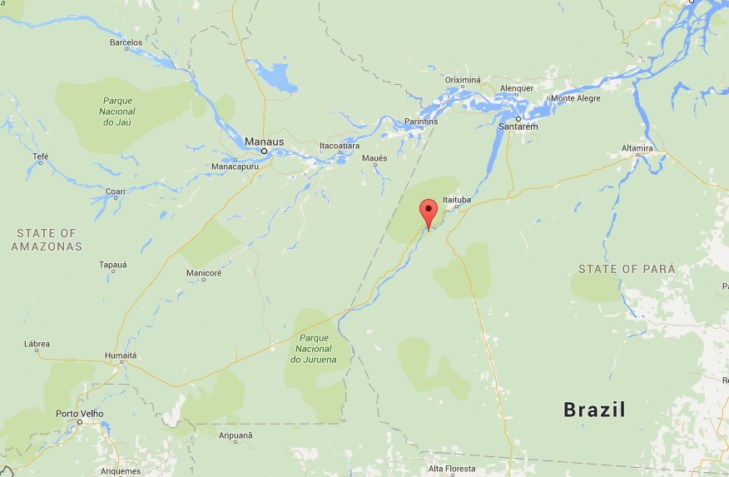
Approximate location of Sawré Muybu demarcation area. Map by Google Maps
FUNAI’s decision to demarcate ends a long-standing and heated political battle between Brazil’s energy sector and Indigenous Peoples in the Tapajós. For at least the last five years, the energy sector has insisted that no Indigenous Peoples have ancestral ties to the region. FUNAI’s announcement brings an end to that argument, confirming that the Munduruku have historical ties to the dam-threatened area.
The final demarcation still depends on a presidential decree that cannot be published for 90 days – a normative timeframe to allow questions and debate to take place – nevertheless, the Munduruku territory is now all but secured from the consequences of the São Luiz do Tapajós dam.
Munduruku cacique (leader) Jairo Saw considers FUNAI’s decision to be an historical victory that indicates the articulation of Indigenous struggles in the Tapajós region.
FUNAI’s President João Pedro Gonçalves da Costa, complimented the cacique’s sentiment, stating that the recognition is unavoidable. “It is impossible and unacceptable to deny the tradition and historical presence of (Munduruku) peoples in the Tapajós,” he said.
THE HYDRO-PROJECT SÃO LUIZ DO TAPAJÓS
The São Luiz do Tapajós dam carried an estimated cost of BRL$32.52 billion (USD$9.12 billion) and would have generated on average 4.012 megawatts per year, about the same as the Belo Monte Dam, also in the state of Pará. On its own, the São Luiz do Tapajós dam would provide almost half the energy of all other hydroelectric plants planned in Brazil for the next ten years, supporting over 20 million homes.
Yet its environmental and human cost was brutal. The São Luiz do Tapajós dam would not only take the Munduruku’s ancestral lands. The total flood area would encompass 729 square kilometers of pristine Amazon rainforest. To put things in perspective, the Belo Monte Dam flood is set to flood 503 square kilometers.
Like the Belo Monte dam, the São Luiz do Tapajós dam has been constantly entangled in judicial irregularities and corruption scandals. In 2014, Brazil’s government announced the dam without an environmental license, a fatal move that forced the government to cancel planning a couple days later. When a judge ordered FUNAI to expedite land demarcation in the affected area, the Federal Government in Brasilia overturned the ruling claiming there was no need for demarcation.
The government stakes were high, placing considerable pressure on then-director of FUNAI Maria Augusta Assirati to uphold the process of land demarcation. She admitted in a meeting with Munduruku authorities that she was expected to secure the hydro dam’s interests.
Just days after that meeting she resigned from her post.
FUNAI held back the land demarcation for years. Jairo Saw, cacique of Sawré Maybu, said that when they realized that they could not count on FUNAI the community decided to start the process of demarcation on its own, autonomous from the government.
In 2016, the dam project was placed on the market once again; the government repeating its past failure to carry out a free, prior and informed consultation process with the Munduruku as required by the Convention 169 of the International Labor Organization (ILO 169).
THE SUPPORT OF BROAD COALITIONS
The absence of land demarcation resulted in various forms of abuse and the mobilization of the UN Special Rapporteur on Indigenous Issues to the region. In March 2016, Victoria Tauli-Corpuz visited Altamira to hear complaints and testimonies about the planning of the hydro-plant. She met with 13 representatives from various communities from the Tapajós river valley: munduruku, arara vermelha, apiaká, arapiun, borari, jaraqui, kumaruara, kayabi, tapajós, tapuia, tupaiú, maytapu, cara preta e tupinambá.
Indigenous Peoples denounced the disrespect of the patrimony through the state of Pará. In addition to hydro dams, they explained at the time they were also victim to the invasion of loggers, mining, agri-business, and even carbon credit projects. The violence on their lands was tacitly permitted by the silence of judicial institutions in Brasilia.
During her visit, Tauli-Corpuz foresaw that it was possible to paralyze the dam construction. She encouraged the Munduruku to continue their resistance. She also talked about her own experience resisting the construction of a dam in the 1970s-1980s in the Philippines. Their unity gave them strength, she later claimed, in a struggle that is not only for the Mundurku but for all Brazilians, for generations to come.
Solidarity ultimately led the way to success. Strong collaborations among communities from the Xingú and Tapajós regions played a crucial role in achieving the land demarcation.
Community leaders from the two regions recently met to celebrate a commitment of cooperation and mutual support. At their gathering, they sealed an agreement to gather all their force to prevent the consequences of the Belo Monte from being repeated in the Tapajós river basin.
In the recent past, the Munduruku also issued the Munduruku Consultation Protocol demanding their right to prior consultation in accordance with international law and Brazil’s constitution.
With the Munduruku and their allies standing at the ready, they now await the President’s decision to uphold the letter and the spirit of Brazilian law.
